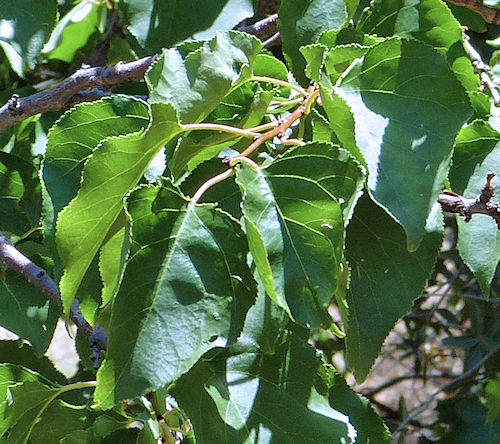Growing Apricots:
Prunus armeniaca
Back to Fruit, Berries and Nuts
Botanical Overview
Apricots, members of the Prunus genus and the Rose family, are closely related to cherries, peaches, plums, and almonds. Prunus armeniaca is the apricot species most widely grown, but other species called apricot are grown in the northern hemisphere. Crosses between apricots and plums, called apriums or pluots depending on the ratio of apricot to plum, are increasingly popular.
Description
Form:
Tree.
Lifespan:
20-40 productive years.
Leaf retention:
Deciduous.
Growth rate:
Moderate to rapid.
Mature Size:
15-30' (4.5-9m) high and 10-20' (3-6m) wide.
Flowers:
White to pink, five petals, appearing singly or in pairs before leaves emerge.
Bloom:
Late winter or early spring. Late frosts can destroy flowers and buds resulting in no fruit
for that year.
Self-fruitful:
Usually. All cultivars can benefit from a second apricot tree to act as a pollen source, but
some require it. Any apricot cultivar can cross-pollinate another.
Years before fruiting:
3-5 before full production, but fruit can start in the second year.
Fruit:
Similar to a peach, the skin is yellow to orange with a red blush on the side facing the
sun, and is smooth or velvety. The flesh is orange, usually firm and not juicy, with a sweet
to tart flavor. The single seed is enclosed in a hard woody shell. The seeds (kernels) of
most cultivars are toxic, containing cyanide, but a few Asian cultivars are sweet, edible
and used as an almond substitute.
Months for fruit to ripen:
3-6, depending on cultivar. They are ripe on the tree when fully orange with no green and
slightly soft.
Storage after harvest:
Apricots that are ripe and still firm can be stored up to one week in a refrigerator. Once
soft, they must be consumed immediately.
Leaves:
Glossy green, wide, rounded with a pointed tip to nearly heart-shaped. Many cultivars turn
red, orange or yellow in the fall.
Stems:
No thorns.
Roots:
Fibrous, usually no more than 30" (75cm) deep.
Apricots are grafted onto rootstock appropriate to local growing conditions.
Cultivars of Note:
Prunus armeniaca 'Gold Kist': Apricot -
USDA hardiness zones 7-9, chill hours 300.
Prunus armeniaca 'Katy': Apricot -
USDA hardiness zones 7-9, chill hours 200-400.
Prunus armeniaca x domestica 'Flavor Delight': Aprium
- USDA hardiness zones 6-10, chill hours 300. A hybrid of three-quarters apricot and
one-quarter plum, and a taste test winner. This tree has the same characteristics as
Apricot and is grown the same way.
Prunus armeniaca x domestica 'Cot N Candy': Aprium
- USDA hardiness zones 7-10, chill hours less than 400. A hybrid of apricot and plum,
with white flesh and a pleasing flavor. This tree is a very early bloomer.
It has the same characteristics as Apricot and is grown the same way.
Wildlife:
The flowers attract bees, the fruit attracts birds and mammals.
Toxic / Danger:
Many parts of plant are toxic, especially the leaves. The seeds of most cultivars are toxic.
The ripe fruit is edible raw, dried or cooked.
Origin:
Northeastern China. The apricot was initially thought to have come from Armenia because its
widespread distribution is quite ancient.
Cultivation and Uses
USDA hardiness zones:
7-10 for 'Gold Kist' and 'Katy', 6-10 for 'Flavor Delight'.
Chill hours:
300 for 'Gold Kist', 200-300 for 'Katy', less than 300 for 'Flavor Delight'.
Heat tolerant:
'Gold Kist', 'Katy' and aprium 'Flavor Delight' grow in hot regions.
Drought tolerant:
Yes, especially on an apricot rootstock.
Sun:
Full sun except afternoon shade in hot desert regions.
Planting:
Locate this tree where it will have full morning sun and afternoon shade in the hottest
months of the year, with well draining soil. The soil in that location must be well draining
and any caliche layer must be removed.
Soil:
Well draining, deep, moderate organic content, pH 6.6-7.8 (neutral to slightly alkaline).
Apricots have medium-low salt tolerance.
Fertilize:
Use an organic fertilizer once a year just before the tree begins to bloom, mid-winter to
mid-spring, depending on the local climate. Spread the fertilizer inside the drip line but
at least 1' from the trunk.
Water after becoming established:
Bubbler or drip irrigate weekly when bearing
fruit, every two weeks otherwise. The water must have very low salt content.
Mulch:
Apply organic material inside the drip line, keeping it 8" (21cm) away from the trunk.
This will keep roots cooler in summer. Some growers also paint the bottom 3' (1m) of the
trunk with tree trunk paint to keep the tree cooler.
Use a rodent gnaw guard at the bottom of the trunk.
Prune:
In early winter, remove all damaged, broken or crossing branches. Remove all branches that do
not grow at a 35-55° angle from the vertical.
Remove all branches within 18" (50cm) of the ground.
Remove marble-sized young fruit so that only one remains every 6" (15cm) along the branch.
Flowers appear on one-year old wood.
Litter:
Flowers after blooming, fruit if not harvested, leaves in the fall.
Propagation:
Cuttings of desirable cultivars are grafted onto seedling rootstock.
Seed does not grow true to its parents and may produce inferior fruit.
Uses:
Edible fruit, shade tree, ornamental.
Do you have additional information or a different experience for these plants that you would like to share? Email info@GardenOracle.com. All contributions are welcome and appreciated.



Latest update: May, 2025
© 2008-2025 by GardenOracle.com

